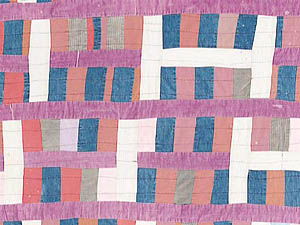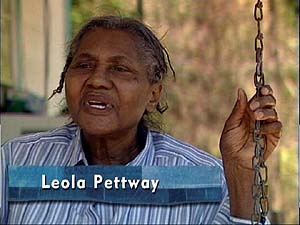|
Quiltmakers and highwaymen
The Highwaymen An artist's work should speak for itself, but it can be refreshing to hear artists speak for themselves as well. These two videos mostly let them do that. Although neither goes especially deep, there is more than enough material from the artists' own mouths to make up for the missing pieces. The Quilts of Gees Bend is a fine introduction to the Alabama women and their quilts that are currently the subject of two books, articles in the New York Times and Newsweek, and an exhibit organized by the Houston Museum of Fine Arts (and now at New York's Whitney Museum). The quilts are beautiful geometric abstractions whose elegance belies the modesty of the women's own accounts of making them in their isolated southern Alabama community. "I loved those pretty ones, but I couldn't make them so I didn't worry about them. I did what I could do. I made what I know how to make," says Loretta Pittway in the video. In fact, of course, the quilts are stunning. The video intersperses loving views of the quilts with the women telling their stories. There is no narration, and much of the gospel soundtrack is supplied by the women, who have been singing and quilting together for decades. Although they make it easy to appreciate the great pleasure they take in their labors, the quilts were born of hard times and necessity. "When I come home I'd do my chores. I washed. I cleaned yard. I mopped. I cooked. I kept my kids cleaned. I fixed their clothes. I ironed their clothes and then I would go to quilting and I would quilt then until about 2 or 3 o'clock in the night. I would get tired but I had to do it. I had to do it cause I had a family and I had to keep them warm because nobody would give me any quilt and I couldn't buy no blankets. And we didn't have no good material. We just pieced out what we could find out of old clothes. I made what I could make. It kept me warm." That necessity, explained here by Loretta Pettway, is highly relevant to the quilts' power. Without the benefit of unaffordable published patterns, and forced to use random bits of fabric from worn-out clothes, the woman were left to the free reign of their imagination in making these quilts.
The Quilts of Gees Bend is a beautiful introduction to their art, though a little light on context. Its references to racial oppression gives no indication of the community's previous bouts of public attention, which include moments of national focus during the depression and the civil rights movement, and specifically a wave of fashionability for the area's quilts in the 1970s.
The Highwaymen video considers a less isolated, less closeknit, congregation of artists centered on Ft. Pierce, Florida, and active as a group mostly in the 1960s. The story of the Highwaymen was told in these pages before. They were young blacks for whom painting was, as they explain in this video, the alternative to field work. "Picking that fruit had a lot to do with me learning to paint," says George Buckner. Art aside, it is a great story, and the video lets the artists tell it. They produced pictures of the Florida landscape in bulk, often traveling along the highway and selling them to professional offices for $30 or so for a 24x36 picture. This video lacks the technical polish evident in The Quilts of Gees Bend, which benefited from the backing of Jane Fonda. But even if their faces occasionally are unlit, the painters give an intriguing account of how they began making pictures, and how and why they kept at it. Hezekiah Baker recalls taking a Famous Artists School course and selling his first five paintings to a motel, which seems appropriate given the usual subject matter of these pretty landscapes. Buckner remembers learning how to mix colors as a way to save money on supplies. These artists were clearly market-driven in a way that sometimes distresses many collectors of self-taught and outsider art. Many of them also received guidance, directly or indirectly, from a trained painter of landscapes, A.E. Backus. Yet, it's not clear that their motivations and approach to work, at least in the early days, were all that different from the women of Gees Bend. The Highwayman -- a name applied to these artists much later -- even worked at times in group sessions. And the involvement with art was not just mercenary. "It was not a passive kind of interest," said Robert Butler. "It was an interest that had to do with breathing and existing psychologically as a person. I could feel good when I drew." The video probes some of these questions, but not deeply. It only touches on the controversy over how seriously to take this work, which to some tastes smacks of superficial kitsch. Yet, defenders find the Highwayman paintings, which their often playful colors and imaginative rendering, not only charming but also artistically rich. This video demonstrates a great deal of the charm and enough of the richness to make for compelling viewing.
|
The Latest Stuff | Roadside art | Outsider pages | The idea barn | About | Home
Copyright Interesting Ideas 2002

